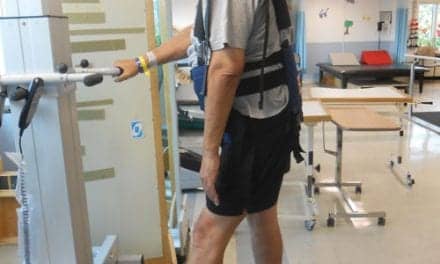Concepts used in the seating clinic help streamline the process for selecting and acquiring adaptive pediatric equipment.
By: Kelly Ann Masterson, PT, DPT
When faced with a stack of catalogs depicting various options, component combinations, and color choices, one may be overwhelmed by the task of selecting the adaptive equipment that will fit just right. It is imperative to consider the needs of the user and caregivers who will be utilizing the equipment, not only from a medical perspective or with regard to therapeutic goals, but also with consideration of their lifestyles. The concept of the seating clinic has been developed to assist with this process as well as to aid in the quest for insurance coverage.
As with any therapeutic intervention within the pediatric environment, it is necessary to establish goals with an emphasis on family-centered care. These include optimal upright seated or standing postures to promote the following:
• Greater independence with mobility across all environments
• Improved sitting tolerance
• Improved standing tolerance with the promotion of healthy bone development via lower extremity weight-bearing activity
• Reduction of the risk of development of orthopedic deformities that result from postural preferences or deviations
• Alternative positioning for the reduction of risk of skin breakdown
• Upright positioning to allow visual scanning of the environment with participation in societal roles and family/peer interaction
• Upright positioning to promote improved respiration, secretion clearance, digestion, and bowel and bladder function
The seating clinic exists as a dynamic environment in which the user, caregivers, and clinicians together brainstorm to arrive at the most appropriate decision. An appointment begins with a comprehensive mat evaluation with an emphasis on biomechanical alignment and functional impairments that may influence equipment selection. The user is assessed in both supine and seated postures; standing posture with the appropriate level of assistance or support also may be assessed when considering the use of a standing frame or gait trainer. Emphasis is placed at the position of the hips, as this serves as the base for seated postures. It is important to examine the influence of pelvic position on midline alignment of the trunk and head to promote visual scanning and exploration of the environment as well as lower extremity positioning.
From the Clinician’s Perspective
The following factors should be considered from a clinician’s perspective: postural preferences, strength deficits with attention to the core and antigravity head control, limited range of motion and joint contractures, tonal abnormalities, pain in the presence of orthopedic deformities with resultant postural compensations, and skeletal alignment. It is also important to assess skin integrity as well as whether there is a history of skin breakdown. In addition to these factors, it is crucial to consider the user’s and caregiver’s perspectives—the adaptive equipment must be functional in consideration of the family’s lifestyle. It is important to consider the ability to fold the adaptive equipment for transport in a personal vehicle as well as the type of terrain that is to be frequently traveled, as this may influence the selection of rear wheels and casters. Aesthetics are also key to consider, as many users and caregivers state that some equipment looks “too medical.”
Pediatric Strollers and Beyond
Given the options available, it is helpful to divide adaptive equipment into categories including adaptive strollers, pediatric manual wheelchairs—lightweight and ultra lightweight versus tilt-in-space— standing frames, and gait trainers. An adaptive stroller may be utilized for a user of small stature. These devices range according to the level of support provided by each model and components. Some strollers are modeled off the jogger prototype while others provide a means of mobility across various settings while easily folding down for transport within a personal vehicle. A lightweight or ultra-lightweight manual wheelchair is typically utilized by a user who is capable of self-propulsion, and this type of manual wheelchair promotes energy conservation for efficient propulsion. Power-assist and/or power wheelchair frames also may be utilized by those who are able to independently propel or drive a wheelchair. A tilt-in-space manual wheelchair may be necessary in the presence of reduced antigravity head control, increased seizure activity, excessive fatigue, and positional changes for those who are dependent for pressure relief.
In addition to the adaptive stroller or wheelchair frame, the appropriate components must be selected to provide positional support. A specific model seat back or cushion may be installed on the stroller or wheelchair frame according to the user’s needs in terms of alignment and skin integrity. When choosing a seat cushion, it is important to inquire about a past medical history of skin breakdown, as this may justify the use of a gel or air-based cushion rather than foam medium. It may not be possible to provide the appropriate positional support with a specific product, such as with orthopedic deformities and scoliosis. In this case, it is beneficial to utilize a custom molded seating system to capture the user’s body shape and provide total surface contact, thereby reducing the risk of skin breakdown secondary to unequal pressure distribution while providing positional support.
Adaptive equipment also includes the use of activity chairs, toileting systems, standing frames, and gait trainers. There is a variety of equipment available with customization based on the user’s needs. This adaptive equipment should be selected with use of the same approach as for a seating and mobility system and should include an assessment of posture, functional impairments, and the role within activities of daily living.
The use of adaptive equipment such as a standing frame and/or gait trainer to allow lower extremity weight-bearing activity is crucial to healthy bone and muscle development. Standing frames are typically categorized according to the orientation of the user and are labeled as prone, supine, or a sit-to-stand type. A dynamic standing frame also may be utilized to allow self-propulsion while in a standing position across various environments via a base similar to that of a wheelchair frame. Gait trainers also may be used to promote muscle strengthening, increased cardiovascular health, and functional endurance while providing a means of greater independence with ambulation. This adaptive equipment can be customized with a wide range of features including swiveling or nonswiveling wheels, brake systems, and flip-down seat to name a few. When choosing an appropriate gait trainer, it is important to consider static and dynamic balance skills as this will likely determine whether the equipment will be utilized in an anterior (push in front) or posterior (pull behind) fashion. In addition to gait trainers, various crutches and canes may be utilized for assistance with balance during ambulation. Aside from the physical and medical benefits, it is also important to consider the psychosocial aspect of the use of an adaptive device that allows the user to see family and peers with interaction at eye level. This can be empowering for the user.
The Criteria Behind a Strong Letter of Medical Necessity
Perhaps the most daunting task of the process exists in the form of writing a letter of medical necessity. There are several key criteria that form a strong letter of medical necessity including the following:
• Introduction to the user including age and diagnosis
• Explanation as to whether the user currently owns adaptive equipment; if so, be sure to specify the reason why the equipment is no longer appropriate for use such as outgrowth or excessive wear and tear
• Explanation as to why the user requires the specific adaptive equipment with medical justification to follow including functional deficits that impact the level of independence across all environments
• Discussion of whether the user trialed the equipment within the clinical setting and the outcome of the trialing process; this is necessary for standing frames and gait trainers
• Inclusion of goals that are specific to the adaptive equipment
• Itemized list of the adaptive equipment and each component with medical justification for use
In addition to a strong letter of medical necessity, it is often necessary to complete a trialing process with the use of a particular standing frame and/or gait trainer prior to order placement for personal use. Clinical notes that document the trialing process will be requested in addition to the letter of medical necessity and should include the following: specific device, distance traveled, level of assistance required, and assessment of gait deviations. It also may be helpful to include an objective measure for comparison of the efficiency of ambulation with and without the adaptive equipment. This allows the clinician to assess the impact of functional impairments on ambulation skills, therefore resulting in the selection of the most appropriate adaptive equipment.
The concepts utilized within the seating clinic environment can be applied to various therapeutic settings with the primary goal being to promote an upright seated or standing posture. This is achieved through an assessment of biomechanical alignment with an emphasis at the pelvis, as this serves as the foundation of a seated posture. Although the emphasis is placed on structure and anatomy, it is crucial to take a step back and consider the lifestyle and needs of the user and caregivers during the selection process. The world of pediatric adaptive equipment is constantly evolving with the development of new products to accommodate seating and positioning needs. RM
Kelly Ann Masterson, PT, DPT, received her Doctorate of Physical Therapy from Quinnipiac University and currently works at the Kennedy Krieger Institute in Baltimore, as a Level II Physical Therapist. She works in both the Seating Clinic and outpatient clinical settings with an emphasis on neurological-based diagnoses in both pediatric and adult populations. For more information, contact [email protected].





